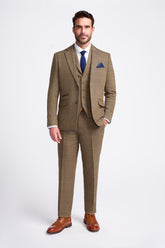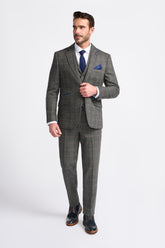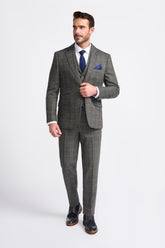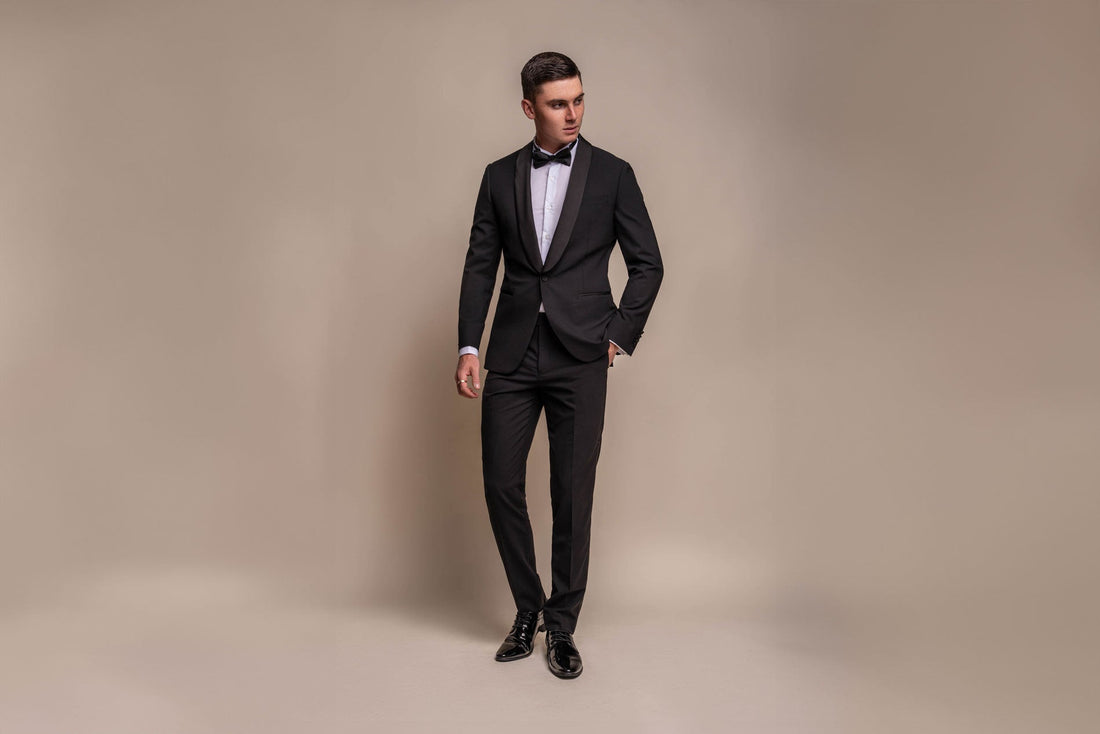Tuxedo vs Suit: What are the Key Differences?
The difference between a tuxedo and suit boils down to more than just the colour and the presence of a bow tie. Despite their similarities, tuxedos and suits both have distinct features that set them apart.
If you’re considering a formal look, it’s important to make the right decision when choosing tuxedo vs suit. Below, we’ll highlight the key differences between the two so that you’ll nail the perfect outfit at your next Christmas party or black-tie event.
How Do You Tell the Difference Between Tuxedo vs Suit?

Tuxedos and suits have a lot in common: both feature the classic combination of a jacket and matching trousers, both can be single or double breasted, and they’re often paired with smart shirts, formal ties, shoes, and other accessories.
So how do you tell the difference between tuxedo vs suit? The answer lies in the detail, and it mostly comes down to one fabric, satin – it’s found on all classic tuxedos and traditional dinner jackets but is generally missing on suit jackets.
You’ll typically find satin or imitation silk on a tuxedo’s lapels, pockets, and trousers which add opulence and sophistication while creating a streamlined silhouette. Suits, on the other hand, generally have a peak lapel and the jacket is made from just one material.
|
|
Tuxedo |
Suit |
Satin / imitation silk |
Subtly featured on lapels, trousers, and trim. |
Not featured on standard suits. |
Jacket |
Silk/satin lapel, buttons, chest pocket trim, and side pocket trim. |
Manufactured from one type of fabric found on the jacket and lapels. |
Lapels |
Always silk/satin, often black but not always. |
Typically the same fabric as the jacket. |
Trousers |
Silk/satin stripe down the outer seam. May also have a silk/satin waistband and mostly feature waist adjusters instead of belt loops. |
No silk/satin stripe and almost always comes with belt loops or adjustable waistbands for added versatility to match different body types. |
Shirt |
Often features a pleated bib, wing-tip collar, or fold-down collar. |
Pretty much anything goes in terms of patterns, designs, and fabrics. |
Buttons |
Satin finish to match the lapels. Tuxedo jackets mostly have only one front button. |
Generally made from plastic, with three buttons for single-breasted jackets and up to six for double-breasted. |
Fabrics |
Typically polyester, wool, or viscose, with satin or imitation silk features. |
Typically polyester, wool, tweed, or viscose. No satin or imitation silk features. |
Colours |
Black or white is most common but also found in contemporary colours such as midnight blue, emerald green, and burgundy. |
From classic navy to bright and bold shades, available in a myriad of colours and patterns to suit any occasion. |
Neckwear |
Mostly a bow tie but comes down to dress code. |
Mostly a necktie but comes down to dress code. |
Shoes |
Classic black patent leather, though colourful velvet loafers are becoming fashionable. |
Endless style and colour options though polished leather and suede are common. |

Tuxedo vs Suit: What is a Tuxedo?

The tuxedo owes its origin to 1860s Britain when the Prince of Wales, later King Edward VII, demanded a new style of relaxed yet formal eveningwear. It soon spread to America where it was first worn at a swanky New York country club called Tuxedo Park, and the name quickly stuck.
Today, the tuxedo has evolved to contain a wide range of styles, cuts, colours, and fabrics and has become the ultimate sartorial symbol of formality and elegance. It remains the go-to choice for black-tie events as well as formal evening attire, weddings, and birthday celebrations.
Traditionally worn with a bow tie, the classic tuxedo colours are black or midnight blue, though different shades and designs are also available. The established way of wearing a tuxedo is with a crisp white dress shirt and black patent leather shoes that complement the satin lapels, buttons, and stripes down each trouser leg. You can also wear a large waist sash known as a cummerbund with a tuxedo, but this is optional rather than necessary.
Tuxedo vs Suit: What is a Suit?

Suits have been worn since the 17th Century when King Charles II of England began to don a matching three-piece outfit. By the 19th Century, suits were in mass production and became cheaper and accessible to almost everyone.
Fast forward to today and suits can be worn at any formal or semi-formal occasion such as weddings and birthdays, are a staple of business wear, and symbolise professionalism and style.
From thicker tweed fabrics to lighter summer designs, suits are available in a huge range of styles, fabrics, colours, and are perfect for all seasons. You can pair a suit colour to your favourite shirt, add a stylish necktie or a pocket square for a formal event or business meeting, or go for an open-neck approach when the setting is less formal. While smart leather shoes are the ideal partner for a sharp suit, you can also get away with a pair of trainers when the mood is more casual.
Tuxedo vs Suit: When Should You Wear Them?
If your invitation says ‘black tie’ you should always reach for your tuxedo. It’s the perfect formal wear solution for any ceremony, prom, dinner party, or celebration.
However, there are also times when a suit is more appropriate, and a tux would simply look out of place. For instance, you’re likely to stick out like a sore thumb in a tuxedo at a beach wedding. So, as a general rule:
Black tie event: Tuxedo.
Formal event: Tuxedo or dark suit.
Business/meeting: Suit.
Semi-formal/casual: Suit.
Prom: Tuxedo.
Tuxedos are also acceptable dress at weddings if the occasion demands it and it comes with a strict, formal dress code. Ultimately, here’s what you should consider:
Daytime Weddings
Most of the time suits are perfectly acceptable daytime wedding attire. After all, daytime weddings often include a colour theme, whereas a tux is traditionally black. Always pay attention to the venue and setting before choosing your suit.
Evening Weddings
Evening weddings often come with a formal dress code, so that should mean a tux. In fact, few outfits look as sleek and elegant as a black tuxedo when the party’s in full swing during the after-dark hours.
Beach Weddings
When the sun’s blazing down and the sea is a shade of vibrant blue, a black tuxedo probably won’t cut it. You’d be much safer sticking with the summery theme and going with a lightweight suit in pale, pastel shades that reflect the heat. Light blue, cream, and pale olive are all popular colours for beach weddings.
Black Tie Weddings
There are two possible dress codes for this type of wedding: black tie or black tie optional. For a black-tie wedding, a tuxedo is appropriate and almost expected. When it’s black tie optional, it’s a chance to choose something less formal and ostentatious than a tux. Instead, go for a darker shade of suit like traditional navy or charcoal grey, and you can always add pops of colour with a bright necktie or pocket square.
Tuxedo vs Suit: We’ve Got You Covered
Tuxedos and suits are reliable staples in men’s formal fashion. While each options has its own distinct features, understanding the subtle nuances will help you select the right outfit your next event or special occasion. Explore our impressive collection of tuxedos and suits at House of Cavani.










